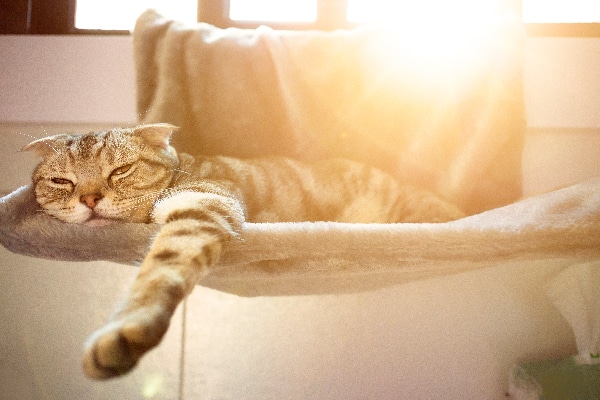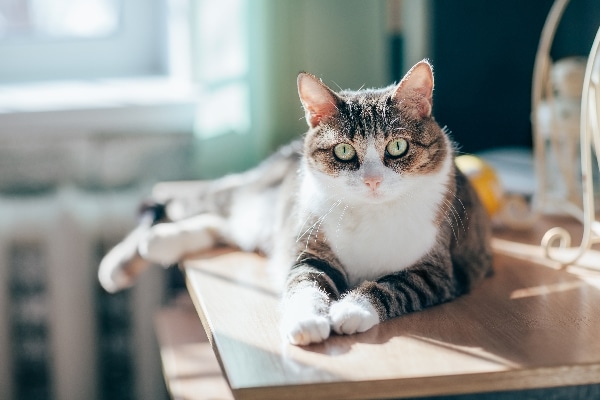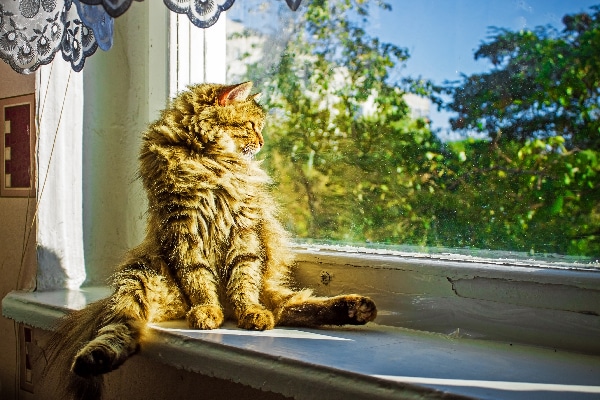Just because our cats can’t complain about extreme summer heat doesn’t mean they’re not feeling the same exhaustion, discomfort and general stickiness we humans are. We’re betting your cat would love to growl about the weather as well … maybe even hiss at that darn meteorologist forecasting 100-degree Fahrenheit heat for the third day in a row. But there comes a point when simply being hot, sweaty and somewhat miserable crosses the line into overheating, and that’s when summer weather turns dangerous for humans and cats alike. Here’s how you can help your cat beat the heat and how to avoid heat stroke in cats this summer.
First, what is heat stroke in cats?

Heat stroke in cats happens when a kitty is exposed to extreme heat and his body loses the ability to regulate its temperature, resulting in overheating. Heat stroke in cats is typically associated with a temperature above 104°F, and it should be taken very seriously.
What are the symptoms of heat stroke in cats?
Overheating in cats is associated with panting and sweaty feet, as this is how kitties release excessive heat. When in danger of heat stroke, your cat may appear restless or groom herself excessively. Symptoms of heat stroke in cats may also include rapid pulse and breathing, vomiting, stumbling and lethargy.
According to Dr. Noreen Overeem, a veterinarian at Rainbow Pet Hospital in Kansas City, Kansas, heat stroke in cats generally presents with an elevated temperature above 106°F or even as high as 109°F. She also says a cat suffering from heat stroke will experience panting and harsh respirations, have glazed eyes and feel hot.
“In advanced cases, the cat may still feel very hot, but [his] paws will now be cold due to very poor circulation as cardiac circulation slows down,” Dr. Overeem says. “Eventually, [the cat] may show small petecchial [bruising] hemorrhages on her abdomen, stupor and even seizures (which will make the temperature rise even higher due to damage to the muscles).”
Why might heat stroke in cats happen?
Just like in humans, heat stroke in cats occurs when a kitty experiences prolonged exposure to an extremely hot environment. Cat overheating can happen regardless of humidity. If the cat can’t find a shaded area or water to help him cool down and regulate his temperature, he is at definite risk of heat stroke.
“Heat stroke … may come from overexertion, usually seizures or having to run a distance in very hot conditions,” Dr. Overeem says. She adds that “situations such as being left inside a car as the car’s internal temperature continues to rise (or) getting caught in a clothes dryer” (two situations that your cat should never be in!) are also instances that can cause heat stroke in cats — and they unfortunately happen more often than you might think.
What cats are most at risk for heat stroke?

Elderly cats and kittens have a harder time regulating their body temperature and as a result have a greater risk of suffering from heat stroke. Overweight cats are also more likely to overheat, and it takes much less exertion for heat stroke to occur. Pre-existing conditions like kidney disease and asthma are also risk factors for heat stroke in cats.
Certain cat breeds — particularly the “snub-nosed,” “flat-faced” or brachycephalic cats — are also at higher risk for heat stroke, including Persians, Himalayans, British Shorthairs and Scottish Folds. And heat stroke in cats is more likely to occur in kitties with thick, dark fur than felines with thin, light-colored fur.
How can you prevent heat stroke in cats?
Keeping your cat indoors, well groomed and hydrated will go a long way toward preventing heat stroke. But if this isn’t possible, Dr. Overeem says getting an overheated cat out of the hot environment (for example, the sun) and on the way to the vet is essential, as an examination will be required to assess whether the kidneys, GI tract or heart have been damaged by the cat overheating. Covering the overheating cat with wet towels and using a fan can also help get kitty’s core temperature down — but Dr. Overeem is adamant that severe heat stroke in cats requires intensive treatment to avoid severe consequences.
“The cat needs immediate treatment. The longer you wait, the worse the internal issues can become,” Dr. Overeem cautions. “Do not wait to see if the cat will get better on her own. Basically, get the cat into the air-conditioned car on the way to the veterinarian.”
Plus, find out how to avoid heat stroke yourself this summer >>
July is the CHILL ZONE on Catster.com! Learn how to keep your cat cool, calm and collected this summer with articles on preventing summer mishaps, staving off stress and more.
Thumbnail: Photography © Yuriyve | iStock / Getty Images Plus.








